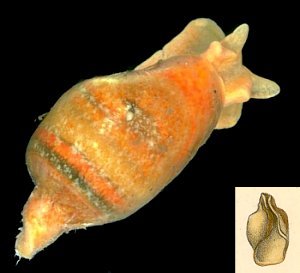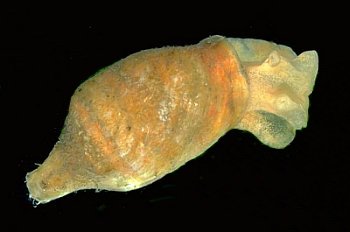

Volvatella vigourouxi
(Montrouzier in Souverbie, 1861)
Order: SACOGLOSSA
Superfamily: OXYNOOIDEA
Family: Volvatellidae
DISTRIBUTION
Known from New Caledonia. Until the species of this genus are better understood it is not possible to be sure of their geographic distributions. This possibly has a wide Indo-West Pacific distribution.
PHOTO
Baie de Koumac, Koumac Region, New Caledonia, 20°34.5'S, 164°15.5'E, 3 m, sandy mud, Caulerpa beds. UPPER: 10 October 1993, 8 specimens (3.5, 5, 6, 13, 20, 20, 21 & 22mm long alive), AM C200412. LOWER: 26 October 1993, 2 specimens, AM C200637. PHOTOS: Bill Rudman.
[INSET in upper photo: Shell of Lophocercus vigourouxi from Montrouzier in Souverbie, 1861: Pl.11, fig.1.]
The species of Volvatella have a large, weakly calcified, bulloid-shaped shell. At its posterior end, the shell narrows into a funnel or spout. The foot is relatively short and the head bears a pair of rounded oral lobes and a pair of somewhat flattened, rounded rhinophores. Species are found in association with their food, the green siphonaceous algae, Caulerpa, on which they are well camouflaged. When disturbed a sticky white secretion is released from a gland in the mantle cavity. The identity of species from the Indo-West Pacific is difficult to resolve as many of the early descriptions are very brief. Volvatella vigourouxi was originally described from New Caledonia only from its shell. However the large, corneous inflated shell is quite recognisable and fits a species commonly found in New Caledonia. It has a distinctively yellow-orange animal, and a relatively long posterior 'siphonal canal' on the shell. Baba (1966) described in detail the anatomy of a species from japan which he identified as V. vigourouxi, but as he had no information on the external features of the living animal, we can't be sure of his identification. See separate discussion on some earlier names.
Reference:
• Baba, K. (1966) Gross anatomy of the specimens of the shelled sacoglossan Volvatella (= Arthessa) collected from Okino-Erabu Island, southern Kyushu, Japan (Nudibranchia). Publications of the Seto Marine Biological Laboratory, 14(3): 197-205, Pls 7-10.
• Souverbie, M (1861) Descriptions d'especes nouvelles de l'archipel Caledonien, (6th article). Journal de Conchyliologie, 9: 271-284. (Pl.11)
Rudman, W.B., 2002 (July 3) Volvatella vigourouxi (Montrouzier in Souverbie, 1861). [In] Sea Slug Forum. Australian Museum, Sydney. Available from http://www.seaslugforum.net/find/volvvigo
Related messages
Volvatella and young
July 16, 2003
From: Trevor Roy

Hello Dr.
I know little to nothing about Nudibranchia so you can imagine my surprise when a hunk of recently purchased live rock (from Fiji I think) with Caulerpa and some other macroalgae I can't identify, produced a bright orange shelled snail/slug with rhinophores.
From scanning many messages it looks like nudibranchs have a variety of different diets(flatworms, sponges, algae). Any way, I do also have a hermit crab population that seems to have dwindled recently, are they potential food sources? Also I am assuming that if this is a Nudibranch that it is in good health so far since it has budded off two others in the last 3 weeks. They seem to start growing off the back side of the large on and then just drop off as little versions.
Any info you can provide would be greatly appreciated. It seems like a very interesting creature and I want to do my best to keep it healthy and happy, and want to know if there is anything potentially hazardous about it.
Thank you
Trevor Roy
trevor.roy@verizon.net


Dear Trevor,
Your animal is a sea slug but not a nudibranch. It is a species of Volvatella, which is one of a group of herbivorous slugs called sacoglossans. It is one of the more primitive sacoglossans still having a large snail-like external shell. Fortunately it feeds on the Caulerpa you have in your tank so unless you are very attached to the Caulerpa, your sea slugs will be happy as long as they have a supply of that to eat. I can't be certain of the Volvatella species as we don't know enough about variation in these species to be sure.
Concerning the large one budding off two babies. Have a look at my message about dwarf males. Although these animals are hermaphrodite as adults, with a fully functional male and female reproductive system, the male system develops first, and so at quite a small size they are able to act as males while the female system is still developing. Small males are often found on the shells of large animals with whom they mate.
Best wishes,
Bill Rudman
Volvatella vigourouxi - dwarf males or impetuous youth?
July 11, 2002
From: Bill Rudman


Kathe Jensen recently reported (1997) small animals riding on the shell of Volvatella ventricosa waiting to copulate. I have have observed this a number of times in Volvatella vigourouxi, including these examples from Koumac in northern New Caledonia.
PHOTOS:
UPPER: Koumac Beach (=Baie de Ouanap), near Koumac, New Caledonia, 20°34'S, 164°16'E, mixed soft and hard substrate, grassbeds, algae, 23 October 1993, 5 specimens, AM C200605.
LOWER: Baie de Koumac, Koumac Region, New Caledonia, 20°34.5'S, 164°15.5'E, 3 m, sandy mud, Caulerpa beds, 10 October 1993, 8 specimens (3.5, 5, 6, 13, 20, 20, 21 & 22mm long alive), AM C200412. [In all cases the lengths are shell lengths]. PHOTOS: Bill Rudman.
When the large animal [AM C200605] in the upper photo was collected it had one dwarf male on the lip of the shell aperture, but when it and and a number of other small individuals were kept together in a dish, all the small animals crawled on to the shell of the large animal, at one time 4 taking up positions along the lip of the aperture. (only 3 in this photo)
The lower photo [AM C200412] represents the 'typical' position with one dwarf male on the edge of the aperture. In this case three out of five large animals collected had dwarf males [21mm - 6mm; 13mm - 3.5mm; 20mm - 5mm] sitting right at the edge of outer lip. To check I attempted to remove one small animal and it was definitely copulating with its penis extending down into its partner's mantle cavity.
Opisthobranchs are considered to be hermaphrodites with functional male and female reproductive organs. There are certainly examples of opisthobranchs in which the male system develops before the female ovary [protandry] and their are many examples amongst other marine snails where the individuals change sex, starting as males and gradually changing to females. To clarify what was happening here, I sectioned a few animals to check the state of their reproductive organs. Larger animals [13-20mm long shells] had a fully developed testis and ovary while in small animals [3.5-6mm long shells], the testis was fully ripe, but the ovary was undeveloped, in fact ovarian tissue could not be identified.
This apparently represents an extreme example of protandrous hermaphroditism. How the life history works would be a fascinating field of study. One possibility is that the large animals are a generation older than the 'dwarfs'. When the large animals die, the 'dwarfs', free from their male 'duties' would be able to grow again and develop their ovaries, ready to take on a 'female' role. Although the large animals have fully mature testes, I have seem no sign of mating between large animals. In the laboratory, small animals readily crawl onto large animals and begin to mate, but I have not seen two large ones do the same.
• Jensen, K.R. (1997) Sacoglossa (Mollusca, Opisthobranchia) from the Darwin Harbour Area, Northern Territory, Australia. In: Proceedings of the Six International Marine Biological Workshop. The marine flora and fauna of Darwin Harbour, Northern Territory, Australia. (Eds: Hanley,JR; Caswell,G; Megirian,D; Larson,HK) Museums and Art Galleries of the Northern Territory and the Australian Marine Sciences Association: Darwin, Australia, Darwin, 163-186.
Best wishes,
Bill Rudman
Volvatella vigourouxi? from Hachijo Island Japan
July 7, 2002
From: Shouichi Kato

Dear Bill,
This animal are found only commonly on Caulerpa sp. during Spring and the
beginning of Summer. It looks Volvatella vigourouxi to me, but I'm not sure.
Please give me your help.
Depth: 2m
Size: 20mm
Regards,
S. Kato
regulus@edit.ne.jp
Kato, S., 2002 (Jul 7) Volvatella vigourouxi? from Hachijo Island Japan. [Message in] Sea Slug Forum. Australian Museum, Sydney. Available from http://www.seaslugforum.net/find/6562Dear Shouichi,
This is possibly Volvatella vigourouxi, but animals I am familiar with from New Caledonia are a much deeper yellow orange in colour, and have a longer siphonal canal on the shell. Have a look at the information I have just posted on this species.
Best wishes,
Bill Rudman
Volvatella vigourouxi and possible synonyms
July 7, 2002
From: Bill Rudman

Volvatella vigourouxi is a good example to illustrate why we have difficulty in giving a name to some species. The identity of the type species of this genus, Volvatella fragilis Pease, (1860a: 20-1., 1868: 73, Pl.7, fig.4), originally described from Hawaii, remains in doubt. Unfortunately, although the genus appears identifiable from the original description, no subsequent author appears able to identify Pease's name with any species known from Hawaii (Evans, 1950., Kay, 1979: 449).
I have included a scan of a section of Plate 42 from Tryon (1893) to illustrate some of the early names. I have also include in a red box Montrouzier's illustration of the shell of V. vigourouxi for comparison. Figs 27-28 show Pease's indeterminate illustrations of Volvatella fragilis, which have far too little detail for species identification. On the other hand Figs 21-23 show the shell of Volvatella pyriformis Pease, 1868 which is almost certainly identical with Volvatella vigourouxi. Since Pease presumably considered his two species to be distinct then it is most unlikely that Volvatella fragilis could be a senior synonym of V. vigourouxi as some authors have previously suggested. Another species, Volvatella cincta Nevill & Nevill, 1869 is illustrated in Figs 33-35. This species from Ceylon is also most probably a synonym of V. vigourouxi, which would indicate that it has a wide distribution in the Indian and Pacific Oceans.
I have also included photos of some old shells from New Caledonia in the Australian Museum collection. They were probably acquired in the 1860s. They show the shape and fragility of the shell.
Lower Left: AM C25547 shell length 18.1mm 'Nouméa, purch: J. Brazier, 5 specimens'.
Lower Right: AM C56612 shell length 18.7mm 'New Caledonia, (no other data)'. Scans by Alison Miller.
References:
• Evans, T.J. (1950) A review of Pease's genus Volvatella, together with a preliminary report on a new saccoglossan genus. Proceedings of the Malacological Society, 28: 102-106.
• Kay, E.A. (1979) Hawaiian Marine Shells. Bernice P. Bishop Museum Special Publication 64(4), (Honolulu)
• Nevill, G. & Nevill, H. (1869) On some new marine gastropoda from the southern province of Ceylon. Journal of the Asiatic Society of Bengal, 38: 65-69.
• Pease, W.H. (1860) Descriptions of new species of Mollusca from the Sandwich Islands. Proceedings of the Zoological Society of London, 28: 18-36.
• Pease, W.H. (1868) Descriptions of marine Gasteropodae, inhabiting Polynesia. Am. J. Conch., 4(2): 71-80. (Pls. 7-10)
• Tryon, G.W. 1893. IN H.A.Pilsbry, Manual of Conchology; Structural and Systematic with Illustrations of the Species. VOL. 15. Polyplacophora, Acanthochitidae, Cryptoplacidae and Appendix. (pp 1-133). Tectibranchiata, 1893 (pp 134-436).
Cheers,
Bill Rudman


